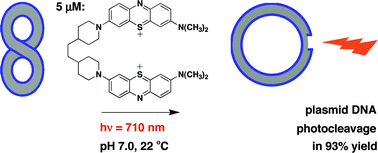Synthesis and DNA interactions of a bis-phenothiazinium photosensitizer†
Abstract
We report the synthesis and characterization of

* Corresponding authors
a
Department of Chemistry, Georgia State University, P.O. Box 4098, Atlanta, GA, USA
E-mail:
kbgrant@gsu.edu
Fax: +1-404-413-5505
Tel: +1-404-413-5522
b
Departamento de Química Orgánica, Universidad de Alcalá, Alcalá de Henares (Madrid), Spain
E-mail:
antonio.lorente@uah.es
Fax: +91 8854686
Tel: +91 8854691
We report the synthesis and characterization of

 Please wait while we load your content...
Something went wrong. Try again?
Please wait while we load your content...
Something went wrong. Try again?
B. Wilson, M. Fernández, A. Lorente and K. B. Grant, Org. Biomol. Chem., 2008, 6, 4026 DOI: 10.1039/B810015B
To request permission to reproduce material from this article, please go to the Copyright Clearance Center request page.
If you are an author contributing to an RSC publication, you do not need to request permission provided correct acknowledgement is given.
If you are the author of this article, you do not need to request permission to reproduce figures and diagrams provided correct acknowledgement is given. If you want to reproduce the whole article in a third-party publication (excluding your thesis/dissertation for which permission is not required) please go to the Copyright Clearance Center request page.
Read more about how to correctly acknowledge RSC content.
 Fetching data from CrossRef.
Fetching data from CrossRef.
This may take some time to load.
Loading related content
